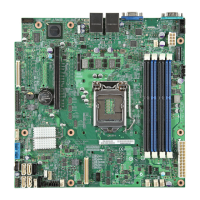Intel® Server Board S1200V3RP TPS Platform Management Functional Overview
Revision 1.2
2. User 2 (“root”) always has the administrator privilege level.
3. All user passwords (including passwords for 1 and 2) may be modified.
User IDs 3-15 may be used freely, with the condition that user names are unique. Therefore, no
other users can be named “” (Null), “root,” or any other existing user name.
6.11.2 IPMB Communication Interface
The IPMB communication interface uses the 100 KB/s version of an I
2
C bus as its physical
medium. For more information on I
2
C specifications, see The I
2
C Bus and How to Use It. The
IPMB implementation in the BMC is compliant with the IPMB v1.0, revision 1.0.
The BMC IPMB slave address is 20h.
The BMC both sends and receives IPMB messages over the IPMB interface. Non-IPMB
messages received by means of the IPMB interface are discarded.
Messages sent by the BMC can either be originated by the BMC, such as initialization agent
operation, or by another source. One example is KCS-IPMB bridging.
6.11.3 LAN Interface
The BMC implements both the IPMI 1.5 and IPMI 2.0 messaging models. These provide out-of-
band local area network (LAN) communication between the BMC and the network.
See the Intelligent Platform Management Interface Specification Second Generation v2.0 for
details about the IPMI-over-LAN protocol.
Run-time determination of LAN channel capabilities can be determined by both standard IPMI
defined mechanisms.
6.11.3.1 RMCP/ASF Messaging
The BMC supports RMCP ping discovery in which the BMC responds with a pong message to
an RMCP/ASF ping request. This is implemented per the Intelligent Platform Management
Interface Specification Second Generation v2.0.
6.11.3.2 BMC LAN Channels
The BMC supports three RMII/RGMII ports that can be used for communicating with Ethernet
devices. Two ports are used for communication with the on-board NICs and one is used for
communication with an Ethernet PHY located on an optional RMM4 add-in module.
6.11.3.2.1 Baseboard NICs
The on-board Ethernet controller provides support for a Network Controller Sideband Interface
(NC-SI) manageability interface. This provides a sideband high-speed connection for
manageability traffic to the BMC while still allowing for a simultaneous host access to the OS if
desired.
The NC-SI is a DMTF industry standard protocol for the side band management LAN interface.
This protocol provides a fast multi-drop interface for management traffic.

